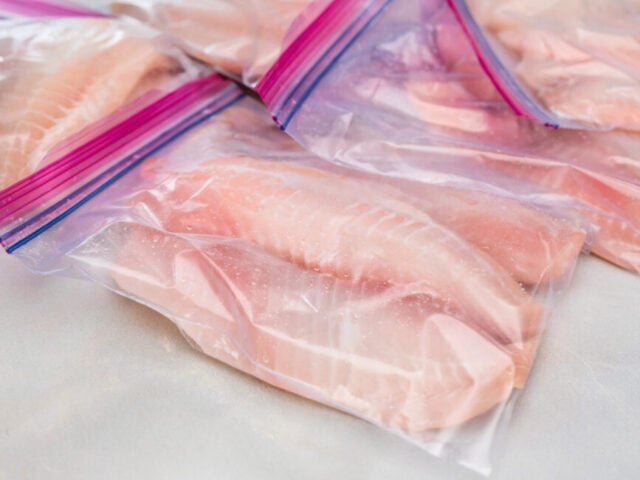When it comes to storing fish, whether it’s fresh off the hook or leftover from last night’s dinner, knowing how long it can safely stay in your refrigerator or freezer is crucial to avoid the unpleasant consequences of spoiled seafood.
From raw to cooked, from fridge to freezer, we’ll cover the key timeframes for optimal storage and share our Steamy Kitchen knowledge on how to extend the shelf life of your seafood.
Today, we are tackling the factors that influence how long fish can remain fresh, signs to look out for when it might be time to say goodbye to your fish, and innovative ways to maximize its shelf life. Let’s dive in, shall we?

The Short Answer
You need to know, and you need to know NOW. How long can fish stay fresh in the fridge? (Drumroll, please…) Raw fish and seafood can chill out in your fridge for 1 to 2 days before it’s begging to be cooked or frozen, while cooked fish can enjoy a slightly extended stay of 3 to 4 days. Commercially-canned fish, like tuna, can last up to 5 years in your pantry, while home-canned fish will only last 1 year. There are a few caveats here, which is what we’re about to get into.

Factors that Affect the Shelf Life of Fish
There are a world of factors that can either extend or reduce the shelf life of fish:
- The Quality of the Fish: Did your fish make a pit stop at the grocery store before it got to you or did you procure it at a fish market? Store-bought fish may have been on ice long before you laid eyes on it, whereas fresh-caught fish from a local fishmonger is, well, as fresh as it gets. The fresher it was to begin with, the longer it will last after being cooked.
- The Coldness of Your Fridge: Fish should be kept in the fridge at 40°F or lower, so make sure your refrigerator temperature is at the right setting.
- Type of Fish: Non-enzymatic spoilage happens due to the oxidation of fish fat. That means fatty fish like salmon or mackerel tend to spoil faster than leaner types of fish due to their fat content.
- Storage: How you store your sea bounty plays a big role in its freshness. Fish that is tightly wrapped in plastic wrap and nestled in the coldest part of the fridge (usually the bottom shelf) will last longer than unwrapped fish, due to the bacteria present in the air.
- What About Room Temperature?: Fish left out for more than 2 hours is basically an open invitation for bacteria to invade. Any temp between 41°F and 135°F is considered the danger zone, so never leave any kind of fish at room temp for longer than 2 hours.
Signs That Your Fish Has Gone Bad
What happens if you eat bad fish? Usually, within a hour, you will experience a multitude of symptoms from what is known as scombroid poisoning. Some of those are more obvious, like nausea, vomiting and diarrhea, but there are many symptoms you might not expect like dizziness, flushing, itching, a rash, sweating and so on. This is why fish is one of those foods you have to be VERY careful about. Because nobody wants to feel that way, here are some ways to tell if your seafood has spoiled:
The Sniff Test: Fresh fish smells like the sea–clean and briny. If your fish smells pungent, fishy, or has an ammonia-like odor, it’s time to bid it farewell.
The Touch Test: Good fish should feel firm, not slimy. If touching your fish feels like a handshake with a jellyfish, it’s a no-go.
The Sight Test: If you see any sign of mold or discoloration, your fish is definitely past its prime.
BUT! Not all improperly stored or expired fish present these obvious indicators, so you can’t trust these alone. Make sure you know where your fish came from, where it’s been stored, and for how long. The mantra here is simple: When in doubt, throw it out. It’s not worth the risk of food poisoning!

Tips on How to Maximize the Shelf Life of Fish
Here are some great ways to ensure your fish stays as fresh as possible:
- Fridge Storage: The best way to store a whole fish (or fish fillets) is to wrap it tightly in plastic wrap or aluminum foil to ward off bacterial growth, and keep it at the bottom of the refrigerator (the last shelf) for no more than 48 hours. If it’s already been cooked, it should keep for about 3 – 4 days.
- Freezer Storage: For those who revere their freezer for its time-stopping abilities, the freezing process is great for fresh seafood! According to the USDA, frozen fish and shellfish of all kinds are safe in the freezer indefinitely. However, that doesn’t mean the flavor and texture will survive forever. For the best quality, you should enjoy frozen cooked fish within 3 months, frozen raw fish within 3 to 8 months, and shellfish within 3 to 12 months. Wrapping your fish tightly is the key to avoiding freezer burn. Using a freezer bag is good, but using a vacuum sealer is even better. If neither work for you, wrap your fish tightly in plastic wrap and then in aluminum foil. When it’s time to thaw, do so in the refrigerator or in cold water, changing the water every 30 minutes to maintain a safe temperature. Cook thawed fish within 1-2 days.
- Home-Canning: If you want to keep your fish around for about a year without using your fridge, your only option is to can it. But first, you’ll need a pressure canner. We’re not the foremost authority on canning, so if that’s something you’re interested in, we suggest checking out this canning tutorial from Sharon of Simply Canning.
- Label it!: For the best results, label your fish with the freezing (or canned) date so you can make sure to use it within the optimal time frame.

More Tips:
Got leftover fish? Transform it into fish cakes, a hearty fish chowder, or flake it over a salad for a yummy protein boost.
Also, did you know that the American Heart Association recommends eating fish at least two times per week? If you’re looking to maintain a healthy diet, consider oily fishes like salmon, tuna and mackerel, because they’re rich in omega-3 fatty acids.
Fishy FAQs
Can I refreeze fish that has been thawed?
It is safe to refreeze fish that has been thawed in the refrigerator, as long as it hasn’t been left in the fridge for more than 2 days. You should note, however, that refreezing may affect the texture and quality of the fish.
How can I tell if frozen fish is still good?
Check for ice crystals and freezer burn. If the fish has been frozen too long, it may have lost some of its quality. If the fish smells and looks good once thawed, the flavor and texture are likely okay.
What’s the best way to defrost fish quickly?
The safest method is in the refrigerator, but if you need a quicker method, you can use cold water. Place the fish in a sealed bag and submerge it in cold water. Make sure you change the water every 30 minutes until it’s thawed. Never, ever defrost fish at room temperature.
You’re a Fish Master!
Now you have all it takes to go forth and enjoy fish in the safest way.
But also, we’d love to hear from you! Do you have any fishy tales to tell? Maybe a favorite fish recipe? Let us know in the comments below!
Want More Fridge Tips?
- How Long Does Lemon Juice Last in the Fridge?
- How Long Does Ginger Last in the Fridge and Freezer?
- How Long Do Green Beans Last in the Fridge and Freezer?
- How Long Does Shredded Chicken Last in the Fridge?







Thank you Jaden, important topic indeed,